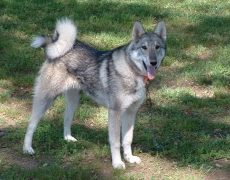East Siberian Laika
The East Siberian Laika is a medium to large size purebred dog that developed in the snow-covered regions of Russia. This Spitz breed was mainly used as hunter-dogs known for their physical strength and protective instinct. They have a large, muscular body covered with thick, long and usually white fur. They are characterized by large head, small almond-shaped eyes, pointed ears, short muzzle, sturdy, well-built legs and a tail curled over its back.
East Siberian Laika Pictures
- East Siberian Laika Dog
- East Siberian Laika Dogs
- East Siberian Laika Images
- East Siberian Laika Photos
- East Siberian Laika Pictures
- East Siberian Laika Puppy
- East Siberian Laika White
- East Siberian Laika
- Images of East Siberian Laika
- Photos of East Siberian Laika
- Pictures of East Siberian Laika
- Vostotchno-Sibirskaia Laika
Quick Description
| Other Names/ Nicknames | Vostotchno-Sibirskaia Laika, ESL |
| Coat | Medium, double, dense |
| Colors | Black, gray, red or any shade of brown; combination of white is very common |
| Type | Purebred |
| Group (of Breed) | Hunting Dog |
| Lifespan | 12-15 years |
| Weight | 35 to 55 pounds (full grown male/female) |
| Size | Large; Males – 48 to 56 cm; Females – 51 to 60 cm |
| Personality Traits | Brave, loyal, intelligent, aggressive, protective, willful, obstinate |
| Good with Children | Yes (if trained from early age) |
| Good with Pets | No |
| Good for New/First-time Owners | No |
| Shedding | Moderate |
| Hypoallergenic | No |
| Country of Origin | Russia |
| Competitive Registration/ Qualification Information | UKC (Northern Breed), FCI, DRA, ACA Breed Standards |
Video: The East Siberian Laikas Attacking Wild Boar
History & Development
Evidence suggests that the East Siberian Laika developed in the 19th century around the Lake Baikal region to the east of the Yenisei River. Breed enthusiasts, however, claim that they originated in the 17th century. However, there is no evidence in support of this view.
The ES Laika is the largest among the 4 Laika-type Russian dogs (with the other three being the West Siberian Laika, the Karelo-Finnish Laika, and the Russo-European Laika) and is believed to have descended from the Aboriginal dogs that closely resembled the Spitz.
They were brought into the region by the immigrants from the West and were mainly used as a hunting dog for both small and large games including squirrels, grouse, marten, sable, moose, wild boar, and even bear and mountain lions.
The early Laikas varied significantly in their physical proportions, some of which are still noted today in the individuals belonging to the breed. The East Siberian Laikas are presently used as a herding dog, as well as a working dog employed to pull sleds.
In 1947, the ES Laika, along with the other three Laika breeds, was recognized for the first time at the All-Union Cynological Congress. Wildlife biologist K. G. Abramov established the first breed standards for this breed in the 1970s. On January 1, 1996, it was recognized by the United Kennel Club.
Temperament and Behavior
Since they developed as a hunting breed, the ES Laikas are extremely aggressive towards big predators and are highly protective of their family members, both adult, and children. Such a trait makes them a good watch dog as well. They are stubborn and independent at times, however, their overall balanced and calm temperament makes them a loyal companion dog.
Care
Exercise
Since they need a good amount of exercise, take them outdoors for a long walk and jogging sessions every day, and let them run around and play until they tire themselves. Make sure you do not keep them leashed when they play, and that, the ground is well-secured by a fence.
Grooming
The ESL has a medium coat. Brush them clean twice or thrice a week. This would also keep its hair smooth and glossy.
Health Problems
Since, unlike most purebreds, it is quite robust and hardy and is not known to inherit any particular diseases down the line, they are said to be one of the healthiest dog breeds of the world. However, some individuals have been reported to develop certain conditions, which not necessarily did affect their parents. Some of these include monorchidism, certain types of cancers, umbilical hernia, elbow and hip dysplasia, etc.
Training
- For a dog that is aggressive and, at times, stubborn, positive reinforcement technique is the keyword to train them. Your dog is fond of you, and hence, never be rude or loud to your dog, especially if it is still a pup. However, never let your dog take over you, or else, it will never consider you as its pack leader when they grow up. When you are walking with your dog, make sure that it’s your dog that is following your footsteps, and never the vice versa. Do maintain a consistent and firm hand in leadership by teaching it the basic commands so that you can effectively have control over your dog’s activities in the future. Get them used to the leash from the prime of their life.
- Socialize your dog in general by taking it to places like dog parks, picnics, arranging for dog parties, or just anything innovative and exciting. Keep refreshing your dog’s training methods throughout its life. They are intelligent creatures and would pick up all that you teach very quickly.
Diet/Feeding
1½ to 2½ cups of dry kibbles is the standard measurement of the total food they should consume per day, including brunch and supper.

















